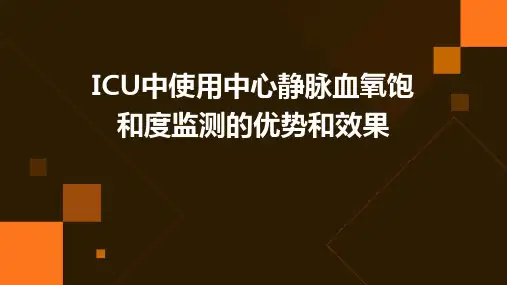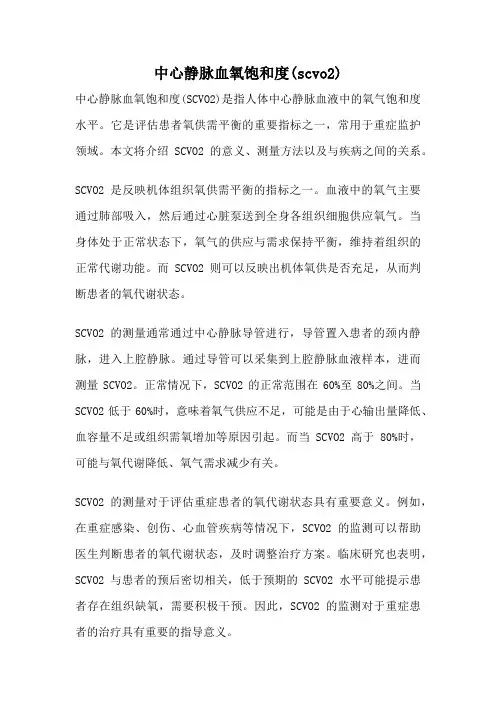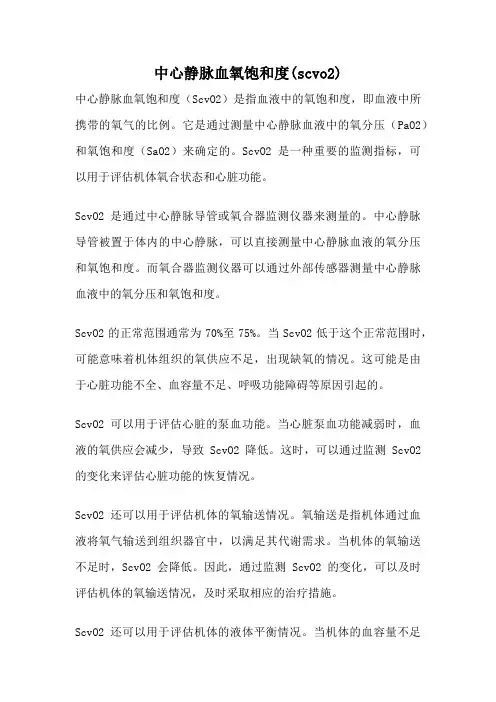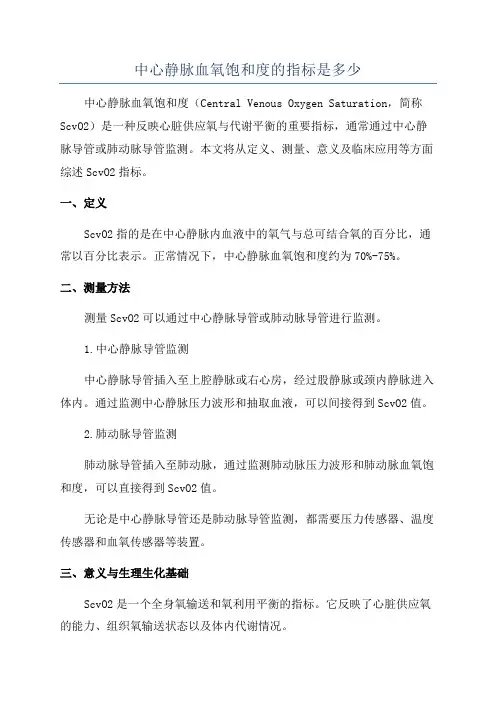中心静脉血氧饱和度监测技术资料
- 格式:pdf
- 大小:3.56 MB
- 文档页数:58






中心静脉血氧饱和度(scvo2)中心静脉血氧饱和度(SCVO2)是指人体中心静脉血液中的氧气饱和度水平。
它是评估患者氧供需平衡的重要指标之一,常用于重症监护领域。
本文将介绍SCVO2的意义、测量方法以及与疾病之间的关系。
SCVO2是反映机体组织氧供需平衡的指标之一。
血液中的氧气主要通过肺部吸入,然后通过心脏泵送到全身各组织细胞供应氧气。
当身体处于正常状态下,氧气的供应与需求保持平衡,维持着组织的正常代谢功能。
而SCVO2则可以反映出机体氧供是否充足,从而判断患者的氧代谢状态。
SCVO2的测量通常通过中心静脉导管进行,导管置入患者的颈内静脉,进入上腔静脉。
通过导管可以采集到上腔静脉血液样本,进而测量SCVO2。
正常情况下,SCVO2的正常范围在60%至80%之间。
当SCVO2低于60%时,意味着氧气供应不足,可能是由于心输出量降低、血容量不足或组织需氧增加等原因引起。
而当SCVO2高于80%时,可能与氧代谢降低、氧气需求减少有关。
SCVO2的测量对于评估重症患者的氧代谢状态具有重要意义。
例如,在重症感染、创伤、心血管疾病等情况下,SCVO2的监测可以帮助医生判断患者的氧代谢状态,及时调整治疗方案。
临床研究也表明,SCVO2与患者的预后密切相关,低于预期的SCVO2水平可能提示患者存在组织缺氧,需要积极干预。
因此,SCVO2的监测对于重症患者的治疗具有重要的指导意义。
除了上述的临床应用,SCVO2还可以帮助医生评估心功能。
由于SCVO2与心脏泵血功能直接相关,当SCVO2下降时,可能提示患者存在心功能不全。
此时,医生可以根据SCVO2的变化调整心脏支持治疗,以改善患者的心功能,并提高SCVO2水平。
在使用SCVO2进行临床监测时,还需要注意一些潜在的限制因素。
例如,导管插入不当、导管位置不准确等因素可能导致SCVO2的测量结果不准确。
此外,还需要考虑到患者自身的特殊情况,如低温、贫血等因素可能影响SCVO2的测量结果。


中心静脉血氧饱和度(scvo2)中心静脉血氧饱和度(ScvO2)是指血液中的氧饱和度,即血液中所携带的氧气的比例。
它是通过测量中心静脉血液中的氧分压(PaO2)和氧饱和度(SaO2)来确定的。
ScvO2是一种重要的监测指标,可以用于评估机体氧合状态和心脏功能。
ScvO2是通过中心静脉导管或氧合器监测仪器来测量的。
中心静脉导管被置于体内的中心静脉,可以直接测量中心静脉血液的氧分压和氧饱和度。
而氧合器监测仪器可以通过外部传感器测量中心静脉血液中的氧分压和氧饱和度。
ScvO2的正常范围通常为70%至75%。
当ScvO2低于这个正常范围时,可能意味着机体组织的氧供应不足,出现缺氧的情况。
这可能是由于心脏功能不全、血容量不足、呼吸功能障碍等原因引起的。
ScvO2可以用于评估心脏的泵血功能。
当心脏泵血功能减弱时,血液的氧供应会减少,导致ScvO2降低。
这时,可以通过监测ScvO2的变化来评估心脏功能的恢复情况。
ScvO2还可以用于评估机体的氧输送情况。
氧输送是指机体通过血液将氧气输送到组织器官中,以满足其代谢需求。
当机体的氧输送不足时,ScvO2会降低。
因此,通过监测ScvO2的变化,可以及时评估机体的氧输送情况,及时采取相应的治疗措施。
ScvO2还可以用于评估机体的液体平衡情况。
当机体的血容量不足时,ScvO2会降低。
通过监测ScvO2的变化,可以及时发现机体的液体平衡问题,并采取相应的调节措施。
总结起来,中心静脉血氧饱和度(ScvO2)是评估机体氧合状态和心脏功能的重要指标。
通过监测ScvO2的变化,可以及时评估机体的氧供应、心脏功能、氧输送和液体平衡情况,并及时采取相应的治疗措施。
因此,在临床实践中,监测ScvO2的变化是非常必要的。



中心静脉血氧饱和度的指标是多少中心静脉血氧饱和度(Central Venous Oxygen Saturation,简称ScvO2)是一种反映心脏供应氧与代谢平衡的重要指标,通常通过中心静脉导管或肺动脉导管监测。
本文将从定义、测量、意义及临床应用等方面综述ScvO2指标。
一、定义ScvO2指的是在中心静脉内血液中的氧气与总可结合氧的百分比,通常以百分比表示。
正常情况下,中心静脉血氧饱和度约为70%-75%。
二、测量方法测量ScvO2可以通过中心静脉导管或肺动脉导管进行监测。
1.中心静脉导管监测中心静脉导管插入至上腔静脉或右心房,经过股静脉或颈内静脉进入体内。
通过监测中心静脉压力波形和抽取血液,可以间接得到ScvO2值。
2.肺动脉导管监测肺动脉导管插入至肺动脉,通过监测肺动脉压力波形和肺动脉血氧饱和度,可以直接得到ScvO2值。
无论是中心静脉导管还是肺动脉导管监测,都需要压力传感器、温度传感器和血氧传感器等装置。
三、意义与生理生化基础ScvO2是一个全身氧输送和氧利用平衡的指标。
它反映了心脏供应氧的能力、组织氧输送状态以及体内代谢情况。
正常情况下,中心静脉血疏各个脏器和组织的代谢产物,并将剩余的氧供应至心脏。
而通过监测ScvO2,可以了解到组织器官的氧输送情况。
ScvO2降低可能说明心脏供应氧量不足,或者组织器官代谢活性增加。
ScvO2降低可能的原因包括但不限于以下几点:1.心脏供应氧减少:例如心脏疾病、心律失常等。
2.氧输送减少:例如出血、休克、低血容量等。
3.组织器官代谢活动增加:例如感染、发热、中毒、癌症等。
同时,ScvO2还可以用于判断血管活性药物使用的指导,以最大程度提高组织氧供。
四、临床应用1. 休克监测:ScvO2可以评估休克患者的组织灌注情况,指导治疗措施。
适应症包括感染性休克、低血容量性休克、心因性休克等。
2. 监测血容量复苏效果:在液体复苏过程中,通过监测ScvO2的变化,可以评估血容量复苏的效果。
中心静脉血氧饱和度中心静脉血氧饱和度
1.1.SVO2的生理意义及测量方法: SVO2系统动态反映全身组织的氧供需状态,参考值范围为65%-75%。
当氧输送减少或者氧需求大于氧供并且超过机体的代偿能力时,SVO2下降,反之当氧输送增加或者氧需小于氧供时SVO2上升。
SVO2测量通过肺动脉漂浮导管,自肺动脉端或右心房直接取血进行血气分析,目前则是通过一种改良纤维光导导管来进行连续性测量。
1.2.SVO2与ScVO2
深静脉穿刺在危重病人的治疗过程中日益常见,它要比肺动脉漂浮导管放置安全和方便,而且可以在监测ScVO2同时测量中心静脉压,所以目前ScVO2更多地被用来监测未留置或不适合留置肺动脉导管的病人。
SVO2&ScVO2
一般在正常成年人中,ScVO2因为测的是上腔静脉的氧饱和度,反映的是上半身包括脑循环的氧平衡情况,而SVO2则评估的是全身,包括腹部及下肢的氧供需状况,而且由于氧的需要不同,腹部及下肢氧饱和度往往高于上腔静脉,于是SVO2比ScVO2的绝对值要高,所以两者在量值上并无法等同。
但是在动态观察两者时,SVO2和ScVO2的变化趋势具有相关性已经得到了证实。
中心静脉血氧饱和度监测技术资料PCCI飞利浦医疗保健2011‐05‐25目 录1.参考文献2.操作指南附:CeVOX导管引导色标CeVOX导管技术参数CeVOX导管使用问答Available online /content/10/6/R158Page 1 of 8(page number not for citation purposes)ResearchMulticentre study on peri- and postoperative central venous oxygen saturation in high-risk surgical patientsCollaborative Study Group on Perioperative ScvO2 MonitoringReceived: 5 Jul 2006Revisions requested: 27 Jul 2006Revisions received: 30 Aug 2006Accepted: 13 Nov 2006Published: 13 Nov 2006Critical Care 2006, 10:R158 (doi:10.1186/cc5094)This article is online at: /content/10/6/R158© 2006 Collaborative Study Group on Perioperative ScvO2 Monitoring; licensee BioMed Central Ltd.This is an open access article distributed under the terms of the Creative Commons Attribution License (/licenses/by/2.0), which permits unrestricted use, distribution, and reproduction in any medium, provided the original work is properly cited.For a complete list of authors and their affiliations, see Appendix. Corresponding author: Stephen M JakobAbstractIntroduction Low central venous oxygen saturation (ScvO 2) has been associated with increased risk of postoperative complications in high-risk surgery. Whether this association is centre-specific or more generalisable is not known. The aim of this study was to assess the association between peri- and postoperative ScvO 2 and outcome in high-risk surgical patients in a multicentre setting.Methods Three large European university hospitals (two in Finland, one in Switzerland) participated. In 60 patients with intra-abdominal surgery lasting more than 90 minutes, the presence of at least two of Shoemaker's criteria, and ASA (American Society of Anesthesiologists) class greater than 2,ScvO 2 was determined preoperatively and at two hour intervals during the operation until 12 hours postoperatively. Hospital length of stay (LOS) mortality, and predefined postoperative complications were recorded.Results The age of the patients was 72 ± 10 years (mean ±standard deviation), and simplified acute physiology score(SAPS II) was 32 ± 12. Hospital LOS was 10.5 (8 to 14) days,and 28-day hospital mortality was 10.0%. Preoperative ScvO 2decreased from 77% ± 10% to 70% ± 11% (p < 0.001)immediately after surgery and remained unchanged 12 hours later. A total of 67 postoperative complications were recorded in 32 patients. After multivariate analysis, mean ScvO 2 value (odds ratio [OR] 1.23 [95% confidence interval (CI) 1.01 to 1.50], p = 0.037), hospital LOS (OR 0.75 [95% CI 0.59 to 0.94], p = 0.012), and SAPS II (OR 0.90 [95% CI 0.82 to 0.99],p = 0.029) were independently associated with postoperative complications. The optimal value of mean ScvO 2 to discriminate between patients who did or did not develop complications was 73% (sensitivity 72%, specificity 61%).Conclusion Low ScvO 2 perioperatively is related to increased risk of postoperative complications in high-risk surgery. This warrants trials with goal-directed therapy using ScvO 2 as a target in high-risk surgery patients.IntroductionSeveral randomised controlled clinical studies have shown improved morbidity and mortality in high-risk surgical patients with perioperative optimisation of haemodynamics using strict treatment protocols in the single-centre setting [1-3]. The haemodynamic endpoints in goal-directed studies have been based on values derived from the pulmonary artery catheter [1-4], oesophageal Doppler [5-10], or (very recently) lithium indi-cator dilution and pulse power analysis [11]. Central venous oxygen saturation (ScvO 2) and mixed venous oxygen satura-tion (SvO 2) have been proposed to be indicators of the oxygen supply/demand relationship. However, the relationship between SvO 2 and ScvO 2 remains controversial [12]. Venousoxygen saturations differ among organ systems because dif-ferent organs extract different amounts of oxygen. It is there-fore conceivable that venous oxygen saturation depends on the site of measurement [13]. Redistribution of blood flow and alterations in regional oxygen demand (for example, in shock,severe head injury, general anaesthesia, as well as microcircu-latory disorders) may affect the difference between ScvO 2 and SvO 2. Although ScvO 2 principally reflects the relationship of oxygen supply and demand, mainly from the brain and the upper part of the body [13], it correlates reasonably well with concomitantly measured SvO 2 [12,13], which is more dependent on changes in oxygen extraction in the gastrointes-tinal tract.HDC = high-dependency care; ICU = intensive care unit; LOS = length of stay; OR = odds ratio; ROC = receiver operator characteristic; SAPS II = simplified acute physiology score; ScvO 2 = central venous oxygen saturation; SvO 2 = mixed venous oxygen saturation.Critical Care Vol 10 No 6Page 2 of 8(page number not for citation purposes)In patients with severe sepsis and septic shock, early ScvO 2-driven haemodynamic treatment was found to reduce mortality [14]. More recently, low postoperative ScvO 2 values were associated with an increased risk of complications in high-risk surgical patients [11]. Despite increasing evidence of benefi-cial effects on outcome, goal-directed therapies are not widely used in clinical practice. The reasons are a lack of demon-strated effect in large multicentre studies, the need for postop-erative intensive care resources, the necessity of instituting complex protocols, as well as the need for monitoring tech-niques that are not routinely used in these specific patient groups. Using the ScvO 2 as a potential target variable for haemodynamic optimisation is attractive because central venous catheterisation is routinely used in high-risk patients undergoing major surgery, ScvO 2 can be screened, pre-emp-tive treatment is possible, and no major changes are neces-sary for the infrastructure in the operation area.The present investigation was a pilot study designed to assess the incidence of low perioperative ScvO 2 in high-risk surgical patients and the association of low ScvO 2 with outcome in a multicentre setting. The aim was to evaluate whether the asso-ciation of ScvO 2 and postoperative complications in a strictly protocolised, interventional single-centre study on goal-directed haemodynamic management in high-risk surgical patients [11] could be confirmed in a purely observational,multicentre setting. Specifically, this pilot study was designed to clarify (a) the recruitment rate of patients scheduled for major surgery in a multicentre setting, (b) the range of periop-erative ScvO 2 in such patients, (c) the number of postopera-tive complications, and (d) the potential association between ScvO 2 and complications. With these data, it should be possi-ble to define whether a trial with goal-directed therapy using ScvO 2 as a target is reasonable to conduct.Materials and methodsTwo university hospitals in Finland and one in Switzerland par-ticipated in the study. The study was approved by the appro-priate ethics committee for each institution, and written informed consent was obtained from each patient. Patients were screened for inclusion and exclusion criteria between September 20 and December 20, 2004.Inclusion criteriaFor a patient to be included in the study, both of the following criteria had to be fulfilled: (a) increased surgical risk based on intra-abdominal or retroperitoneal surgery with an expected duration of at least 90 minutes or on abdominal aortic surgery and (b) two or more of Shoemaker's criteria of high risk [2].These criteria include patient history (more than 70 years old with limited major physiological function, previous severe car-diopulmonary or vascular illness, and severe nutritional disor-ders), current clinical condition (severe multiple trauma,massive acute blood loss, shock, septicaemia or septic shock,respiratory failure, acute abdominal catastrophe, and acuteintestinal or renal failure), the surgical procedure (extensive surgery for cancer or prolonged surgery more than eight hours), ASA (American Society of Anesthesiologists) class of greater than two, and a perioperative need for a central venous catheter.Exclusion criteriaExclusion criteria for the study were a contraindication for a central venous catheter, unstable angina pectoris, primary hepatic or hepato-biliary surgery, the refusal of blood prod-ucts, and the inability to give informed consent or refusal to consent.Study protocolAnaesthesia, operation, and postoperative treatment were performed according to the local standards. All patients were postoperatively admitted either to an intensive care unit (ICU)or another high-dependency care (HD C) area (intermediate care unit or postanaesthesia care unit). Blood samples for the measurement of ScvO 2 and haemoglobin were taken after induction of anaesthesia and thereafter at two hour intervals up to 12 hours postoperatively. Blood gas analyses were per-formed by intermittent blood sampling and co-oximetry (ABL 725; Radiometer, Copenhagen, Denmark [centres 1 and 2];GEM Premier 3000; Instrumentation Laboratory, Barcelona,Spain [centre 3]).ComplicationsComplications and deaths occurring within 28 days of enrol-ment were included in the data analysis. Complications were prospectively defined and were diagnosed by clinical staff.Length of stay in the study hospital was censored at 28 days,and the patient's location at 28 days was recorded.StatisticsData are presented as mean ± standard deviation when nor-mally distributed, as medians (interquartile range) when not normally distributed, or (for categorical variables) as a percent-age of the group from which they were derived. Normality was tested with the Kolmogorov-Smirnov test. Categorical data were tested with Fisher's exact test. Continuous data were tested with the t test when normally distributed and with the Mann-Whitney U test when not normally distributed. Trends in physiological parameters over time were compared with repeated-measures analysis of variance.Univariate analysis was performed to test associations with complications and death. For data recorded hourly during the study period, the baseline values, the lowest values, and the mean over the 12-hour study period were tested. A multiple logistic regression model was used to identify independent risk factors for postoperative complications. A stepwise approach was used to enter new terms into the logistic regres-sion model, where p < 0.05 was set as the limit for inclusion of new terms. Results of logistic regression are reported asAvailable online /content/10/6/R158Page 3 of 8(page number not for citation purposes)adjusted odds ratios (ORs) with 95% confidence intervals (CIs). Receiver operator characteristic (ROC) curves were constructed to identify optimal cutoff values for association with outcome. The optimum cutoff was defined as the value associated with the highest sum of sensitivity and specificity.Analysis was performed with SPSS version 12.01 (SPSS Inc.,Chicago, IL, USA) and Sigma Plot version 10.01 (Systat Soft-ware, Inc., Richmond, CA, USA) software, and significance was set at p < 0.05.ResultsOf 218 screened patients, 60 patients fulfilled requirements for both inclusion and exclusion criteria and gave written informed consent (21 females, 39 males). Their mean age was 72 ± 10 years, and simplified acute physiology score (SAPS II) was 32 ± 12. In two centres, all patients were elective sur-gical cases, whereas in the third centre, 12 out of 21 patients were emergencies. Demographics and outcome data as well as indications for laparatomy stratified for the three centres are indicated in Table 1. Mean SAPS II scores in the three centres were 30, 26, and 40, respectively, and the associated mortal-ity rates were 0%, 6%, and 24%, respectively.As compared with preoperative values, ScvO 2 was lower immediately after surgery. Haemoglobin decreased (preopera-tive 110 ± 19 g/l versus 102 ± 17 g/l immediately after sur-gery, p = 0.003).Overall length of stay in the ICU/HDC was 1.0 (0 to 1) days,and hospital LOS was 10.5 (8 to 14) days (observation period 28 days). Six patients died (28-day mortality 10%); three of them were emergency cases (28-day mortality in emergency cases 25%).Sixty-seven postoperative complications were recorded in 32patients (20 cardiorespiratory, 23 surgical, 19 infectious, and 5 other; between 1.0 and 1.3 per patient per centre). Univari-ate analysis identified nine variables associated with postoper-ative complications (Table 2). Six of them were ScvO 2variables (Figure 1a,b). Additionally, haemoglobin (111 ± 18versus 105 ± 23 g/l, p = 0.018), SAPS II (27 ± 11 versus 45± 26, p = 0.003), and hospital LOS (10 [8 to 12] versus 14[10 to 17] days, p = 0.001) were associated with postopera-tive complications.After multivariate analysis, mean ScvO 2 value (OR 1.23 [95%CI 1.01 to 1.50], p = 0.037), hospital LOS (OR 0.75 [95% CI 0.59 to 0.94], p = 0.012), and SAPS II (OR 0.90 [95% CI 0.82 to 0.99], p = 0.029) were independently associated with postoperative complications. ROC curves for these variables are displayed in Figure 2. The areas under the ScvO 2 and SAPS II, but not LOS, ROC curves were significantly different from 0.5 (p = 0.004 and 0.002, respectively). The optimal value of mean ScvO 2 for discriminating between patients who did or did not develop complications was 73% (sensitivityTable 1Demographics and outcome data stratified for the three centresAll centres (n = 60)Centre 1 (n = 17)Centre 2 (n = 22)Centre 3 (n = 21)Age in years 72 ± 1068 ± 1172 ± 974 ± 10Male/female 40/2013/418/416/5SAPS II a32 ± 1226 ± 1030 ± 440 ± 14Emergency surgery (percentage)200057Aortic/iliacal aneurysm/dissection (percentage)47825014Carcinoma upper abdomen (percentage)121255Carcinoma lower abdomen (percentage)2464138Infection (percentage)70419Other (percentage)100024Duration of operation (minutes)218 ± 111323 ± 92178 ± 81177 ± 99Hospital LOS (days)11 (8 to 14)13 (11 to 15)8 (4 to 10)11 (9 to 14)Patients at home on day 28 (percentage)65239038Patients in hospital/nursing facility on day 28 (percentage)2265538Unknown patient location on day 28 (percentage)3650Mortality (percentage)10624a One-way analysis of variance (p < 0.01). LOS, length of stay; SAPS II, simplified acute physiology score.Critical Care Vol 10 No 6Page 4 of 8(page number not for citation purposes)72%, specificity 61%). The relation between ScvO 2 and hos-pital LOS in survivors and non-survivors is displayed in Figure 3.DiscussionThe main finding of this study was that in the multicentre set-ting, low ScvO 2 during the peri- and postoperative period was associated with an increased risk of postoperative complica-tions in high-risk patients undergoing major surgery. Our results support the feasibility of testing ScvO 2 as a target var-iable to improve outcome in high-risk surgery. The criteria to define patients at high risk were pragmatic and clinically ori-ented and resulted in a sufficient recruitment rate. Further-more, despite the relative heterogeneity of the patient population, ScvO 2 had a reasonable predictive value for post-operative complications.Pearse et al . [11] found that low minimum ScvO 2 values during the first eight postoperative hours were associated with increased risk of postoperative complications. Their findingsTable 2Variables associated with postoperative complicationsPatients with complications (n = 32)Patients without complications (n = 28)P value aScvO 2 (percentage)Preoperative 74 ± 1080 ± 90.031IntraoperativeAfter 1 hour of surgery 74 ± 1080 ± 90.046After 2 hours of surgery 73 ± 1280 ± 110.022After 3 hours of surgery 71 ± 1181 ± 80.001Lowest 60 ± 764 ± 70.036Mean70 ± 574 ± 60.005Haemoglobin at ICU admission (g/l)95 ± 17105 ± 130.018SAPS II41 ± 1427 ± 110.003Hospital LOS (days)13 ± 710 ± 40.001a Univariate analysis of variance. ICU, intensive care unit; LOS, length of stay; SAPS II, simplified acute physiology score; ScvO2, central venousoxygen saturation.Figure 1Intraoperative (a) and postoperative (b) ScvO 2 variables in patients who did and did not develop postoperative complications. P values correspond to univariate analysis of variance. ICU, intensive care unit; IMC, intermediate care unit; intraop, intraoperative; preop, preoperative; postop, postoper-ative; ScvO 2, central venous oxygen saturation.Available online /content/10/6/R158Page 5 of 8(page number not for citation purposes)Figure 2Receiver operator characteristic (ROC) analysis for (a) mean ScvO 2, (b) SAPS II score, and (c) hospital length of stay (LOS). Outcome parameter for ROC analysis is occurrence of postoperative complications. Area under the curve (AUC) was 0.74 for mean ScvO 2 (p = 0.004), 0.78 for SAPS II score (p = 0.002), and 0.61 for LOS (p = 0.15). SAPS II, simplified acute physiology score; ScvO 2, central venous oxygen saturation.Figure 3Central venous oxygen saturation (ScvO 2) (percentage) in survivors and non-survivors and in patients with high and low mean ScvO 2 values. The numbers above the error bars indicate the corresponding LOS data for the different sub-groups. *Wilcoxon signed rank test versus preoperative (p < 0.05). #Mann-Whitney test versus ScvO 2 >73% (p= 0.001). ICU/IMC, intensive care unit/intermediate care unit; LOS, length of stay in hospital.Critical Care Vol 10 No 6Page 6 of 8(page number not for citation purposes)come from a strictly protocolised, interventional single-centre study on goal-directed haemodynamic management in high-risk surgical patients. Our results further confirm the associa-tion between ScvO 2 and postoperative complications in a purely observational, multicentre setting. Furthermore, intraop-eratively, we were able to demonstrate a significant difference in ScvO 2 between patients who did and did not develop com-plications. Taken together, the present study and that of Pearse et al . suggest that the overall peri- and postoperative course of ScvO 2 should be taken into account if ScvO 2-tar-geted interventions are considered for testing in large-scale clinical trials.Despite the relative similarity of the participating centres and the presence of comparable infrastructures for postoperative care, the hospital LOS varied widely between the centres. The reason for this is certainly multifactorial and likely to include,among other things, care processes within the individual cen-tres, discharge policies, and variations in local health care organisation. These variations were likely to dilute any associ-ation between ScvO 2 and length of stay in the relatively small sample size. Hence, we used clinically relevant predefined complications as the main outcome measure. The hospital mortality in the present study was comparable with the recent study of Pearse et al . [11] and clearly lower than what would be expected from several previous studies on high-risk sur-gery. Due to the small sample size and different proportions of emergency patients, relevant between-centre comparisons cannot be made.The prognostic significance of ScvO 2 less than 65% has been demonstrated in myocardial infarction [15], trauma [16],severe sepsis [17], and cardiac failure [18]. However, the only interventional trial of ScvO 2 conducted so far used a target of 70% [14]. In the study of Pearse et al . [11], a level of 65%seemed to discriminate best between patients with and without complications. This may be related to the lower tissue oxygen delivery in surgical patients as compared with patients with sepsis. D espite complex physiology, the association between ScvO 2 and outcome after major surgery seems to be similar to the association between cardiac index and outcome or between oxygen delivery and outcome [19-22].The best cutoff for ScvO 2 in predicting complications in our study was 73%. This corresponds well with the mean ScvO 2of 75% found by Pearse et al . [11] in patients who did not develop complications. The observed cutoff value of ScvO 2should be interpreted with some caution due to the sample size. Nevertheless, the somewhat higher best cutoff of ScvO 2for predicting complications in our study could be related to the fact that our study was observational, whereas Pearse et al . used protocolised treatment. When using protocols, the fluctuation in ScvO 2 is likely to be reduced. This may also explain why in our study the mean ScvO 2, rather than the min-imum ScvO 2, had predictive value.In our study, the perioperative mean of ScvO 2 was 74% in patients who did not develop postoperative complications.This is comparable with previous measurements in healthy subjects [23] and in patients after surgery [11,22] but is higher than in patients with favourable outcome after severe sepsis, trauma, cardiac failure, or myocardial infarction [15-18]. Accordingly, targets for ScvO 2 in future prospective trials should probably be adapted to the specific study groups.We believe that our results encourage trials with goal-directed therapy using ScvO 2 as a target in high-risk surgery patients.Based on our data and in agreement with results from others [11], target values should be in the range of 70% to 75%, and values less than 65% should be strictly avoided. In patients with cardiac failure or trauma, lower targets (at approximately 65%) may be appropriate [15,16].Obviously, in a multicentre approach, the inclusion of 60patients with an observed 28-day mortality of 10% is enough to be able to demonstrate a benefit in terms of complication rate but not in terms of length of stay and mortality. To demon-strate a relative reduction in 28-day mortality of 34% (as in the study of Rivers et al . [14], with a beta error of 80% and an alpha error of 5%, the sample size in a patient group similar to that in this study would be 85 for both groups. Although the risk factors for postoperative complications agree well with previous studies, the small sample size for the multivariate analysis should be considered in interpreting our results.Because oxygen demands are normally well controlled during general anaesthesia, efforts to increase ScvO 2 should target oxygen delivery (arterial oxygen saturation, haemoglobin, and cardiac output). In fact, in this trial, preoperative haemoglobin concentrations were significantly lower in patients with com-plications as compared with patients without. To avoid sudden drops in ScvO 2 as a consequence of the combination of hypo-volaemia and anaemia during surgical bleeding, it may be pru-dent to correct low (<10 g/dl) preoperative haemoglobin concentrations.A drop in ScvO 2 was noted between the end of surgery and the first readings in the ICU. This finding is consistent with pre-vious findings on ScvO 2 [11] and SvO 2 [19,21] in surgical patients. Both decreased systemic oxygen delivery and increased oxygen consumption may have contributed. Pearse et al . [11] reported unchanged cardiac output in the postoper-ative period. If this was the same in our patients, oxygen deliv-ery still could have decreased due to the significantly lower postoperative haemoglobin concentrations. Postoperative oxygen consumption is determined by various factors, includ-ing pain, emergence from anaesthesia, body temperature, and shivering. To avoid low postoperative ScvO 2, all of these fac-tors may have to be controlled.Available online /content/10/6/R158Page 7 of 8(page number not for citation purposes)ConclusionIn our study, low ScvO 2 was frequently observed in patients during and after major surgery and was related to postopera-tive complications. In prospective trials using ScvO 2 as a goal,the specific patient group has to be taken into account when target levels are peting interestsThe authors declare that they have no competing interests. No author received individual funding in connection with this study.Authors' contributionsHB performed programming of databases for all centres, data acquisition, data analysis, calculation of statistics and manu-script revision. VE, DI, SL, IP, CR, and AV provided data acqui-sition and manuscript revision. MH carried out data acquisition and interpretation and manuscript revision. SMJ participated in the study design and coordination, performed the measure-ments, and wrote a first draft of the manuscript. HL and SN recruited patients, performed data acquisition, data analysis and interpretation, and manuscript revision. KM and PM carried out patient recruitment, data acquisition, and manu-script revision. MN and ER performed data interpretation and manuscript revision. JT provided study conception and design,data interpretation, and manuscript revision. All authors were given the opportunity to read and approve the final manuscript.AppendixThe Collaborative Study Group on Perioperative ScvO 2 Moni-toring is composed of authors from three centres:Bern:Hendrik Bracht 1, Verena Eigenmann 2, Matthias Haenggi 1,Daniel Inderbitzin 3, Stephan M Jakob 1 (co-principal investiga-tor), Stefanie Loher 1, Christine Raeber 1, Jukka Takala 1 (coordi-nating investigator), Andreas Vogt 7Kuopio:Kimmo Mäkinen 5, Pekka Miettinen 5, Minna Niskanen 6, Ilkka Parviainen 6 (co-principal investigator)Tampere:Heli Leppikangas 4, Silvia Nunes 4, Esko Ruokonen 4 (co-princi-pal investigator)1Department of Intensive Care Medicine, University HospitalBern, CH-3010 Bern, Switzerland2D epartment of Cardiovascular Surgery, University HospitalBern, CH-3010 Bern, Switzerland3Department of Visceral and Transplantation Surgery, Univer-sity Hospital Bern, CH-3010 Bern, Switzerland4Department of Intensive Care, Tampere University Hospital,P.O. Box 2000, 33521 Tampere, Finland5Department of Surgery, Kuopio University Hospital, P.O. Box1777, 70211 Kuopio, Finland6Department of Anesthesia and Intensive Care Medicine, Kuo-pio University Hospital, P.O. Box 1777, 70211 Kuopio,Finland7Department of Anesthesiology, University Hospital Bern, CH-3010 Bern, SwitzerlandAcknowledgementsThis study was supported by a grant from Edwards Lifesciences.References1.Boyd O, Grounds RM, Bennett ED: A randomized clinical trial of the effect of deliberate perioperative increase of oxygen deliv-ery on mortality in high-risk surgical patients. JAMA 1993,270:2699-2707.2.Shoemaker WC, Appel PL, Kram HB, Waxman K, Lee TS: Pro-spective trial of supranormal values of survivors as therapeu-tic goals in high-risk surgical patients. Chest 1988,94:1176-1186.3.Wilson J, Woods I, Fawcett J, Whall R, D ibb W, Morris C,McManus E: Reducing the risk of major elective surgery: ran-domised controlled trial of preoperative optimisation of oxy-gen delivery. BMJ 1999, 318:1099-1103.4.Polonen P, Ruokonen E, Hippelainen M, Poyhonen M, Takala J: Aprospective, randomized study of goal-oriented hemodynamic therapy in cardiac surgical patients. Anesth Analg 2000,90:1052-1059.5.McKendry M, McGloin H, Saberi D, Caudwell L, Brady AR, SingerM: Randomised controlled trial assessing the impact of a nurse delivered, flow monitored protocol for optimisation of circulatory status after cardiac surgery. BMJ 2004, 329:258.6.Gan TJ, Soppitt A, Maroof M, el-Moalem H, Robertson KM, MorettiE, D wane P, Glass PS: Goal-directed intraoperative fluid administration reduces length of hospital stay after major surgery. Anesthesiology 2002, 97:820-826.7.Mythen MG, Webb AR: Perioperative plasma volume expan-sion reduces the incidence of gut mucosal hypoperfusion dur-ing cardiac surgery. Arch Surg 1995, 130:423-429.8.Sinclair S, James S, Singer M: Intraoperative intravascular vol-ume optimisation and length of hospital stay after repair of proximal femoral fracture: randomised controlled trial. BMJ 1997, 315:909-912.9.Venn R, Steele A, Richardson P, Poloniecki J, Grounds M, New-man P: Randomized controlled trial to investigate influence of the fluid challenge on duration of hospital stay and periopera-tive morbidity in patients with hip fractures. Br J Anaesth 2002,88:65-71.10.Wakeling HG, McFall MR, Jenkins CS, Woods WG, Miles WF,Barclay GR, Fleming SC: Intraoperative oesophageal Doppler guided fluid management shortens postoperative hospital stay after major bowel surgery. Br J Anaesth 2005,95:634-642.Key messages• Low ScvO 2 perioperatively is related to increased risk ofpostoperative complications in high-risk surgery.• Trials with goal-directed therapy using ScvO 2 as a tar-get in high-risk surgery patients are warranted.。